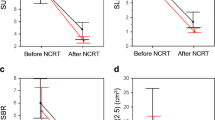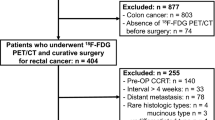Abstract
Purpose
To investigate the association between 18fluorine-2-deoxy-d-glucose positron emission tomography–computed tomography (18F-FDG PET/CT) parameters, serum carcinoembryonic antigen (CEA), and tumor response in patients with rectal cancer receiving neoadjuvant chemoradiotherapy (nCRT).
Methods
Sixty-four patients with T3-4 and/or node-positive rectal cancer receiving nCRT followed by surgery were prospectively studied. PET/CT was performed before, and in 28 patients, both before and after nCRT. The pre-/post-nCRT maximum standardized uptake (SUVmax) values, differences between pre-/post-nCRT SUVmax (∆SUVmax), response index of SUVmax (RI-SUVmax), mean standardized uptake value (SUVmean), metabolic tumor volume (MTV), total lesion glycolysis (TLG), and CEA were measured. The ability of PET/CT parameters and CEA to predict Mandard’s tumor regression grade (TRG) and pathological complete remission (pCR) were evaluated.
Results
31 patients were identified as responders (TRG 1–2), and 19 exhibited pCR. For responders, significant differences were found for ΔSUVmax (24.88 vs. 15.39 g/ml, p = 0.037), RI-SUVmax (0.76 vs. 0.63, p = 0.025), ΔSUVmean (14.43 vs. 8.65 g/ml, p = 0.029), RI-SUVmean (0.77 vs. 0.63, p = 0.011), CEA-pre (6.30 vs. 27.86 μg/L, p < 0.001), CEA-post (2.22 vs. 5.49 μg/L, p = 0.002), ΔCEA (4.08 vs. 23.13 μg/L, p < 0.001), and RI-CEA (0.25 vs. 0.55, p = 0.002). Differences between pCR and non-pCR patients were noted as RI-SUVmean (0.77 vs. 0.65, p = 0.043), MTV-pre (9.87 vs. 14.62 cm3, p = 0.045), CEA-pre (5.62 vs. 22.27 μg/L, p = 0.002), CEA-post (1.95 vs. 4.72 μg/L, p = 0.001), and ΔCEA (3.68 vs. 17.99 μg/L, p = 0.013). Receiver operating characteristic analysis revealed that RI-SUVmean exhibited the greatest accuracy in predicting responders, whereas CEA-post and ΔCEA exhibited the greatest accuracy in predicting pCR.
Conclusions
18F-FDG PET/CT parameters and CEA are accurate tools for predicting tumor response to nCRT in rectal cancer.


Similar content being viewed by others
References
Sauer R, Becker H, Hohenberger W, et al. (2004) Preoperative versus postoperative chemoradiotherapy for rectal cancer. N Engl J Med 351:1731–1740
Guillem JG, Chessin DB, Cohen AM, et al. (2005) Long-term oncologic outcome following preoperative combined modality therapy and total mesorectalexcision of locally advanced rectal cancer. Ann Surg 241:829–836 (discussion 836–838)
Habr-Gama A, de Souza PM, Ribeiro U Jr, et al. (1998) Low rectal cancer: impact of radiation and chemotherapy on surgical treatment. Dis Colon Rectum 41:1087–1096
Konski A, Li T, Sigurdson E, et al. (2009) Use of molecular imaging to predict clinical outcome in patients with rectal cancer after preoperative chemotherapy and radiation. Int J Radiat Oncol Biol Phys 74:55–59
Chen ET, Mohiuddin M, Brodovsky H, Fishbein G, Marks G (1994) Downstaging of advanced rectal cancer following combined preoperative chemotherapy and high dose radiation. Int J Radiat Oncol Biol Phys 30:169–175
Mandard AM, Dalibard F, Mandard JC, et al. (1994) Pathologic assessment of tumour regression after preoperative chemoradiotherapy of esophageal carcinoma. Clinicopathologic correlations. Cancer 73:2680–2686
Maas M, Nelemans PJ, Valentini V, et al. (2010) Long-term outcome in patients with a pathological complete response after chemoradiation for rectal cancer: a pooled analysis of individual patient data. Lancet Oncol 11:835–844
Habr-Gama A, Perez RO, Nadalin W, et al. (2004) Operative versus nonoperative treatment for stage 0 distal rectal cancer following chemoradiation therapy: long-term results. Ann Surg 240:711–717 (discussion 717–718)
Kim CJ, Yeatman TJ, Coppola D, et al. (2001) Local excision of T2 and T3 rectal cancers after downstaging chemoradiation. Ann Surg 234:352–358 (discussion 358–359)
Kuo LJ, Chern MC, Tsou MH, et al. (2005) Interpretation of magnetic resonance imaging for locally advanced rectal carcinoma after preoperative chemoradiation therapy. Dis Colon Rectum 48:23–28
Buijsen J, van Stiphout RG, Menheere PP, Lammering G, Lambin P (2014) Blood biomarkers are helpful in the prediction of response to chemoradiation in rectal cancer: a prospective, hypothesis driven study on patients with locally advanced rectal cancer. Radiother Oncol 111:237–242
Maffione AM, Ferretti A, Grassetto G, et al. (2013) Fifteen different 18F-FDG PET/CT qualitative and quantitative parameters investigated as pathological response predictors of locally advanced rectal cancer treated by neoadjuvant chemoradiation therapy. Eur J Nucl Med Mol Imaging 40:853–864
Hoffmann KT, Rau B, Wust P, et al. (2002) Restaging of locally advanced carcinoma of the rectum with MR imaging after preoperative radio-chemotherapy plus regional hyperthermia. Strahlenther Onkol 178:386–392
Denecke T, Rau B, Hoffmann KT, et al. (2005) Comparison of CT, MRI and FDG-PET in response prediction of patients with locally advanced rectal cancer after multimodal preoperative therapy: is there a benefit in using functional imaging? Eur Radiol 15:1658–1666
Calvo FA, Domper M, Matute R, et al. (2004) 18F-FDG positron emission tomography staging and restaging in rectal cancer treated with preoperative chemoradiation. Int J Radiat Oncol Biol Phys 58:528–535
Niccoli-Asabella A, Altini C, De Luca R, et al. (2014) Prospective analysis of 18F-FDG PET/CT predictive value in patients with low rectal cancer treated with neoadjuvant chemoradiotherapy and conservative surgery. Biomed Res Int. doi:10.1155/2014/952843
Rosenberg R, Herrmann K, Gertler R, et al. (2009) The predictive value of metabolic response to preoperative radiochemotherapy in locally advanced rectal cancer measured by PET/CT. Int J Colorectal Dis 24:191–200
Choi H, Yoon HJ, Kim TS, et al. (2013) Voxel-based dual-time 18F-FDG parametric imaging for rectal cancer: differentiation of residual tumor from postchemoradiotherapy changes. Nucl Med Commun 34:1166–1173
Maffione AM, Chondrogiannis S, Marzola MC, et al. (2014) Biological target volume overlapping segmentation system method for avoiding false-positive PET findings in assessing response to neoadjuvant chemoradiation therapy in rectal cancer. Clin Nucl Med 39:e215–e219
Tulchinsky H, Shmueli E, Figer A, Klausner JM, Rabau M (2008) An interval >7 weeks between neoadjuvant therapy and surgery improves pathologic complete response and disease-free survival in patients with locally advanced rectal cancer. Ann Surg Oncol 15:2661–2667
Kim JW, Kim HC, Park JW, et al. (2013) Predictive value of (18)FDG PET-CT for tumour response in patients with locally advanced rectal cancer treated by preoperative chemoradiotherapy. Int J Colorectal Dis 28:1217–1224
Shanmugan S, Arrangoiz R, Nitzkorski JR, et al. (2012) Predicting pathological response to neoadjuvant chemoradiotherapy in locally advanced rectal cancer using 18FDG-PET/CT. Ann Surg Oncol 19:2178–2185
Perez RO, Habr-Gama A, São Julião GP, et al. (2014) Predicting complete response to neoadjuvant CRT for distal rectal cancer using sequential PET/CT imaging. Tech Coloproctol 18:699–708
Lin JZ, Pan ZZ, Zeng ZF, Ding PR, Wan DS (2009) Multivariate analysis of clinicopathologic factors correlated with pathological complete response following preoperative radiotherapy in rectal adenocarcinoma. Ai Zheng 28:919–922
Yang KL, Yang SH, Liang WY, et al. (2013) Carcinoembryonic antigen (CEA) level, CEA ratio, and treatment outcome of rectal cancer patients receiving pre-operative chemoradiation and surgery. Radiat Oncol 8:43
Author information
Authors and Affiliations
Corresponding authors
Ethics declarations
Conflict of interest
The authors declare that they have no conflict of interest or source of external funding.
Ethical Approval and Informed Consent
All procedures performed in studies involving human participants were in accordance with the ethical standards of the institutional research committee and with the 1964 Helsinki declaration and its later amendments or comparable ethical standards. Informed consent was obtained from all individual participants included in this study.
Additional information
Qi-Wen Li and Rong-Liang Zheng contributed equally to this work.
Electronic supplementary material
Below is the link to the electronic supplementary material.
Rights and permissions
About this article
Cite this article
Li, QW., Zheng, RL., Ling, YH. et al. Prediction of tumor response after neoadjuvant chemoradiotherapy in rectal cancer using 18fluorine-2-deoxy-d-glucose positron emission tomography–computed tomography and serum carcinoembryonic antigen: a prospective study. Abdom Radiol 41, 1448–1455 (2016). https://doi.org/10.1007/s00261-016-0698-7
Published:
Issue Date:
DOI: https://doi.org/10.1007/s00261-016-0698-7




